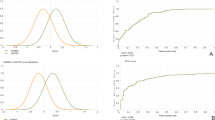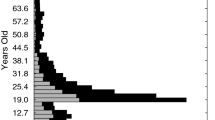Abstract
Background
Genetic syndromes often have ocular involvement. Ophthalmologists may have difficulty identifying dysmorphic features in genetic syndrome evaluations. We investigated the sensitivity and specificity of Face2Gene (F2G), a digital image analysis software trained on integrating dysmorphic features, by analysing patient photos from genetics textbooks.
Methods
We analysed all clear facial photos contained within the textbooks Smith’s Recognizable Patterns of Human Malformation and Genetic Diseases of the Eye using F2G under standard lighting conditions. Variables captured include colour versus grey scale photo, the gender of the patient (if known), age of the patient (if known), disease categories, diagnosis as listed in the textbook, and whether the disease has ophthalmic involvement (as described in the textbook entries). Any photos rejected by F2G were excluded. We analysed the data for accuracy, sensitivity, and specificity based on disease categories as outlined in Smith’s Recognizable Patterns of Malformation.
Results
We analysed 353 photos found within two textbooks. The exact book diagnosis was identified by F2G in 150 (42.5%) entries, and was included in the top three differential diagnoses in 191 (54.1%) entries. F2G is highly sensitive for craniosynostosis syndromes (point estimate [PE] 80.0%, 95% confidence interval [CI] 56.3–94.3%, P = 0.0118) and syndromes with facial defects as a major feature (PE 77.8%, 95% CI 52.4–93.6%, P = 0.0309). F2G was highly specific (PE > 83percentage with P < 0.001) for all disease categories.
Conclusions
F2G is a useful tool for paediatric ophthalmologists to help build a differential diagnosis when evaluating children with dysmorphic facial features.
Similar content being viewed by others
Introduction
There is a myriad of systemic genetic diseases in childhood with eye involvement. Facial dysmorphism is often a key component of syndromes involving the eye [1]. In a tertiary paediatric anterior segment service, 26.5–38% of patients may present with dysmorphic facial features [2]. Making a syndromic diagnosis is a key step in identifying genetic disease that could inform future treatment. However, ophthalmologists usually lack the necessary training in identifying and evaluating dysmorphic features.
Computer-learning algorithms can be used to analyse digital images and aid in the diagnostic process. These algorithms have already proven useful in clinical ophthalmology. Recently, a digital image processing software showed a 92.5% accuracy in diagnosing diabetic retinopathy based on fundus photos [3]. Face2Gene (F2G, FDNA Inc. Boston, MA, USA) is a smart-phone based computerized facial dysmorphology analysis program that analyses 2-dimensional facial images to provide a list of thirty differential diagnoses of syndromes (Face2Gene. https://www.face2gene.com/. Accessed September 10, 2019). Such algorithms are powerful tools in generating genetic syndrome differential diagnoses and may play an increasingly important role in an era of pandemic-driven telehealth delivery. In this study, we assessed the sensitivity and specificity of F2G when used to analyse images of a wide variety of genetic syndromes from two popular genetics textbooks.
Subjects and methods
The Face2Gene algorithm was downloaded from the Apple App Store and installed on to an iPhone 9 (Apple Inc., Cupertino, California, United States of America). The algorithm was activated and registered according the manufacturer instructions. Under standard lighting, all clear facial photographs without any hardware (e.g. tracheostomy tube) contained within the textbooks Smith’s Recognizable Patterns of Human Malformation, 7th Edition and Genetic Diseases of the Eye, 2nd Edition were captured and analysed using F2G [3, 4]. Once analysed, the F2G output includes 30 “Suggested Syndromes” listed in the most- to least-likely diagnosis, along with a “gestalt score” for each syndrome. If an age-series of photographs was presented, we used the oldest photograph available for each patient. Variables captured include colour versus grey-scale photo, the gender of the patient (if known), age of the patient (if known), disease categories, diagnosis as listed in the textbook, and whether the disease has ophthalmic involvement (as described in the textbook entries). One photo per patient was included. Any photos rejected by the F2G algorithm were excluded. We analysed the data for accuracy, sensitivity, and specificity based on disease categories as outlined in Smith’s Recognizable Patterns of Malformation, 7th Edition due to limited sample size for any single diagnosis.
Results
A total of 353 facial images from the two textbooks were analysed. The top F2G diagnosis matched the book diagnosis in 150 (42.5%) entries, while it is included in the top three in 191 (54.1%) images. Of the 259 entries with ophthalmic involvement, the top F2G diagnosis matched the book diagnosis in 108 (49.4%) entries, while the book diagnosis is included in the top three differential diagnoses in 140 (54.1%) entries. F2G was able to successfully assign images to 21 of the 22 book categories. No single diagnosis occurred in the books more than eight times.
F2G is highly sensitive for craniosynostosis syndromes (point estimate [PE] 80.0%, 95% confidence interval [CI] 56.3–94.3%, P = 0.0118) and syndromes with facial defects as a major feature (PE 77.8%, 95% CI 52.4 – 93.6%, P = 0.0309). F2G was highly specific (PE > 90% with P < 0.001) and demonstrated a significant negative predictive probability (PE > 83 % with P < 0.0001) in all 21 categories of disease that it identified. Photograph colour, gender and age did not have any significant correlation to outcomes.
Discussion
The importance of computer-learning algorithm in clinical medicine has been increasing steadily over the past decade, with the first artificial intelligence software for the detection of diabetic retinopathy approved by the U.S. Food and Drug Administration in 2018 [5, 6]. The 2019 coronavirus disease pandemic has hastened the worldwide uptake of telehealth across all clinical specialties [7], and computer-based algorithms such as F2G will likely become increasingly central in the remote diagnosis and management of diseases [8]. This is the first study on using smart-phone artificial intelligence algorithm in the diagnosis of syndromes involving ocular anomalies. We found F2G to be highly specific for assigning patients with dysmorphic features into the 21 categories in Smith’s Recognizable Patterns of Human Malformation, 7th Edition, suggesting that it may be useful to rule out certain syndrome types in the settings of ambiguous clinical findings and/or history. F2G is highly sensitive for craniosynostosis syndromes and syndromes with facial defects as a major feature, and there was a higher accuracy in the subgroup with eye involvement. This makes F2G particularly suitable for eye care professional to generate syndromic differential diagnoses when an ophthalmic finding is suspected to be a part of a syndromic constellation. Overall, the algorithm had modest accuracy in identifying the book diagnoses both as the top diagnosis and within the top three potential diagnoses, although previous studies have reported high accuracy in using F2G to differentiate between limited numbers of diagnoses based on photos [9,10,11]. This discrepancy may be due to the breadth of diagnostic spectra tested in this study, and the variable quality/resolution of the standard photographs contained within the textbooks. F2G is designed as a cloud-based application and it is conceivable that with further machine learning using a real-time, evolving database, the accuracy of the program will improve over time.
This study has several limitations. Although lighting conditions were standardized for each image capture, exact positioning, size, and shape of photos varied. Our analysis did not include race, a variable that previous studies have reported to affect F2G’s analytical parameters [12]. Last, as smart phone camera resolutions and functions improve over time, our method of “taking the photo of a photo” may not be generalizable to subsequent generations of smart devices. Future studies may focus on the impact of supplemental demographic information on diagnostic accuracy, sensitivity, and specificity. In summary, F2G may be a useful tool for ophthalmologists to generate a reasonable list of differential diagnoses when evaluating a child with suspected syndromes.
Summary
What is known before
-
Genetic syndromes are frequently encountered in the paediatric ophthalmology clinic.
-
Facial dysmorphoogy recognition is a difficult skill for non-geneticists to acquire.
-
Smart-phone based facial recognition algorithm Face2Gene may be a substitute, but its sensitivity and specific has not been tested with standardized photographs.
What this study adds
-
Face2Gene algorithm was highly sensitive for craniosynostosis syndromes and syndromes with facial feature as a major feature.
-
Face2Gene algorithm was highly specific for all disease categories.
References
Pillai GS, Radhakrishnan N. Ocular manifestations of pediatric systemic diseases. Indian J Pediatr. 2018;85:217–27.
Hoguet A, Grajewki AL, Hodapp EA, Chang TC. A retrospective survey of childhood glaucoma prevalence according to Childhood Glaucoma Research Network classification. Indian J Ophthalmol. 2016;64:118–23.
Jones KL,JM, Campo M, Smith’s recognizable patterns of human malformation. 7 ed. 2013, Elsevier Health Sciences, W B Saunders Co Ltd., USA.
Genetic diseases of the eye. 2 ed. 2012, New York: Oxford University Press.
Savoy M. IDx-DR for diabetic retinopathy screening. Am Fam Physician. 2020;101:307–8.
van der Heijden AA, et al. Validation of automated screening for referable diabetic retinopathy with the IDx-DR device in the Hoorn Diabetes Care System. Acta Ophthalmol. 2018;96:63–8.
Smith AC, et al. Telehealth for global emergencies: Implications for coronavirus disease 2019 (COVID-19). J Telemed Telecare. 2020;26:309–13.
Elmas M, Gogus B. Success of face analysis technology in rare genetic diseases diagnosed by whole-exome sequencing: a single-center experience. Mol Syndromol. 2020;11:4–14.
Danyel M, et al. Differentiation of MISSLA and Fanconi anaemia by computer-aided image analysis and presentation of two novel MISSLA siblings. Eur J Hum Genet. 2019;27:1827–35.
Liehr T, et al. Next generation phenotyping in Emanuel and Pallister-Killian syndrome using computer-aided facial dysmorphology analysis of 2D photos. Clin Genet. 2018;93:378–81.
Vorravanpreecha N, et al. Studying Down syndrome recognition probabilities in Thai children with de-identified computer-aided facial analysis. Am J Med Genet A. 2018;176:1935–40.
Pantel JT, et al. Advances in computer-assisted syndrome recognition by the example of inborn errors of metabolism. J Inherit Metab Dis. 2018;41:533–9.
Acknowledgements
We wish to acknowledge Mr. Manuel Grosskopf & Family for their generous support of the Samuel & Ethel Balkan International Pediatric Glaucoma Center, and their tremendous foresight in the value of artificial intelligence clinical research.
Funding
The project was supported by the National Institute of Health (NIH) Center Core Grant P30EY014801, Research to Prevent Blindness Unrestricted Grant, The 2019 University of Miami Institute for Advanced Study of the Americas Pilot Grant, 2018 IRIS-Registry-AGS Research Initiative Grant, and Grant Number UL1TR002736, Miami Clinical and Translational Science Institute, from the National Center for Advancing Translational Sciences and the National Institute on Minority Health and Health Disparities. Its contents are solely the responsibility of the authors and do not necessarily represent the official views of the NIH.
Author information
Authors and Affiliations
Contributions
MJJ, EAV, ALG, and TCC all contributed to the study design and data analysis. TCC collected the data and composed the manuscript. All authors had access to the data and approved the manuscript.
Corresponding author
Ethics declarations
Conflict of interest
The authors declare no competing interests.
Additional information
Publisher’s note Springer Nature remains neutral with regard to jurisdictional claims in published maps and institutional affiliations.
This study was presented at a paper presentation at the American Association of Pediatric Ophthalmology & Strabismus 2019 Annual Meeting in San Diego, CA.
Rights and permissions
About this article
Cite this article
Javitt, M.J., Vanner, E.A., Grajewski, A.L. et al. Evaluation of a computer-based facial dysmorphology analysis algorithm (Face2Gene) using standardized textbook photos. Eye 36, 859–861 (2022). https://doi.org/10.1038/s41433-021-01563-5
Received:
Revised:
Accepted:
Published:
Issue Date:
DOI: https://doi.org/10.1038/s41433-021-01563-5
This article is cited by
-
Rare genetic disorders in India: Current status, challenges, and CRISPR-based therapy
Journal of Biosciences (2024)
-
Next generation phenotyping for diagnosis and phenotype–genotype correlations in Kabuki syndrome
Scientific Reports (2024)



